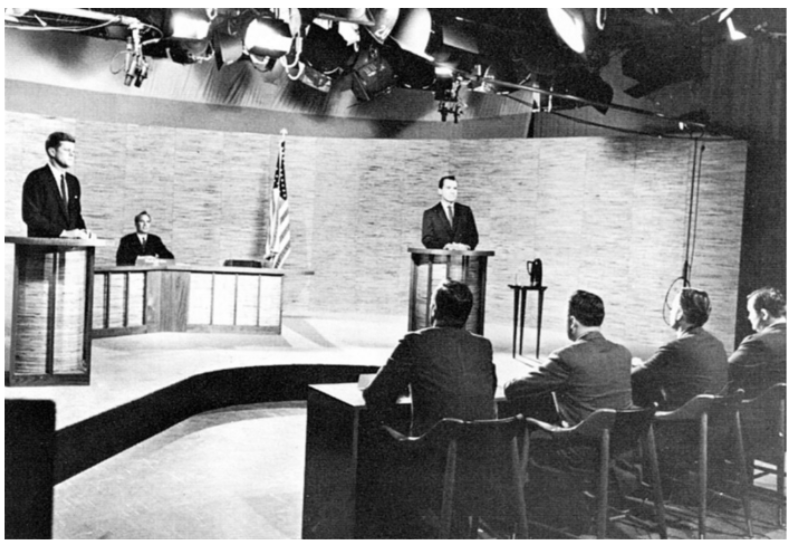1.3: Elements of the Communication Process
- Page ID
- 54892
\( \newcommand{\vecs}[1]{\overset { \scriptstyle \rightharpoonup} {\mathbf{#1}} } \)
\( \newcommand{\vecd}[1]{\overset{-\!-\!\rightharpoonup}{\vphantom{a}\smash {#1}}} \)
\( \newcommand{\id}{\mathrm{id}}\) \( \newcommand{\Span}{\mathrm{span}}\)
( \newcommand{\kernel}{\mathrm{null}\,}\) \( \newcommand{\range}{\mathrm{range}\,}\)
\( \newcommand{\RealPart}{\mathrm{Re}}\) \( \newcommand{\ImaginaryPart}{\mathrm{Im}}\)
\( \newcommand{\Argument}{\mathrm{Arg}}\) \( \newcommand{\norm}[1]{\| #1 \|}\)
\( \newcommand{\inner}[2]{\langle #1, #2 \rangle}\)
\( \newcommand{\Span}{\mathrm{span}}\)
\( \newcommand{\id}{\mathrm{id}}\)
\( \newcommand{\Span}{\mathrm{span}}\)
\( \newcommand{\kernel}{\mathrm{null}\,}\)
\( \newcommand{\range}{\mathrm{range}\,}\)
\( \newcommand{\RealPart}{\mathrm{Re}}\)
\( \newcommand{\ImaginaryPart}{\mathrm{Im}}\)
\( \newcommand{\Argument}{\mathrm{Arg}}\)
\( \newcommand{\norm}[1]{\| #1 \|}\)
\( \newcommand{\inner}[2]{\langle #1, #2 \rangle}\)
\( \newcommand{\Span}{\mathrm{span}}\) \( \newcommand{\AA}{\unicode[.8,0]{x212B}}\)
\( \newcommand{\vectorA}[1]{\vec{#1}} % arrow\)
\( \newcommand{\vectorAt}[1]{\vec{\text{#1}}} % arrow\)
\( \newcommand{\vectorB}[1]{\overset { \scriptstyle \rightharpoonup} {\mathbf{#1}} } \)
\( \newcommand{\vectorC}[1]{\textbf{#1}} \)
\( \newcommand{\vectorD}[1]{\overrightarrow{#1}} \)
\( \newcommand{\vectorDt}[1]{\overrightarrow{\text{#1}}} \)
\( \newcommand{\vectE}[1]{\overset{-\!-\!\rightharpoonup}{\vphantom{a}\smash{\mathbf {#1}}}} \)
\( \newcommand{\vecs}[1]{\overset { \scriptstyle \rightharpoonup} {\mathbf{#1}} } \)
\( \newcommand{\vecd}[1]{\overset{-\!-\!\rightharpoonup}{\vphantom{a}\smash {#1}}} \)
\(\newcommand{\avec}{\mathbf a}\) \(\newcommand{\bvec}{\mathbf b}\) \(\newcommand{\cvec}{\mathbf c}\) \(\newcommand{\dvec}{\mathbf d}\) \(\newcommand{\dtil}{\widetilde{\mathbf d}}\) \(\newcommand{\evec}{\mathbf e}\) \(\newcommand{\fvec}{\mathbf f}\) \(\newcommand{\nvec}{\mathbf n}\) \(\newcommand{\pvec}{\mathbf p}\) \(\newcommand{\qvec}{\mathbf q}\) \(\newcommand{\svec}{\mathbf s}\) \(\newcommand{\tvec}{\mathbf t}\) \(\newcommand{\uvec}{\mathbf u}\) \(\newcommand{\vvec}{\mathbf v}\) \(\newcommand{\wvec}{\mathbf w}\) \(\newcommand{\xvec}{\mathbf x}\) \(\newcommand{\yvec}{\mathbf y}\) \(\newcommand{\zvec}{\mathbf z}\) \(\newcommand{\rvec}{\mathbf r}\) \(\newcommand{\mvec}{\mathbf m}\) \(\newcommand{\zerovec}{\mathbf 0}\) \(\newcommand{\onevec}{\mathbf 1}\) \(\newcommand{\real}{\mathbb R}\) \(\newcommand{\twovec}[2]{\left[\begin{array}{r}#1 \\ #2 \end{array}\right]}\) \(\newcommand{\ctwovec}[2]{\left[\begin{array}{c}#1 \\ #2 \end{array}\right]}\) \(\newcommand{\threevec}[3]{\left[\begin{array}{r}#1 \\ #2 \\ #3 \end{array}\right]}\) \(\newcommand{\cthreevec}[3]{\left[\begin{array}{c}#1 \\ #2 \\ #3 \end{array}\right]}\) \(\newcommand{\fourvec}[4]{\left[\begin{array}{r}#1 \\ #2 \\ #3 \\ #4 \end{array}\right]}\) \(\newcommand{\cfourvec}[4]{\left[\begin{array}{c}#1 \\ #2 \\ #3 \\ #4 \end{array}\right]}\) \(\newcommand{\fivevec}[5]{\left[\begin{array}{r}#1 \\ #2 \\ #3 \\ #4 \\ #5 \\ \end{array}\right]}\) \(\newcommand{\cfivevec}[5]{\left[\begin{array}{c}#1 \\ #2 \\ #3 \\ #4 \\ #5 \\ \end{array}\right]}\) \(\newcommand{\mattwo}[4]{\left[\begin{array}{rr}#1 \amp #2 \\ #3 \amp #4 \\ \end{array}\right]}\) \(\newcommand{\laspan}[1]{\text{Span}\{#1\}}\) \(\newcommand{\bcal}{\cal B}\) \(\newcommand{\ccal}{\cal C}\) \(\newcommand{\scal}{\cal S}\) \(\newcommand{\wcal}{\cal W}\) \(\newcommand{\ecal}{\cal E}\) \(\newcommand{\coords}[2]{\left\{#1\right\}_{#2}}\) \(\newcommand{\gray}[1]{\color{gray}{#1}}\) \(\newcommand{\lgray}[1]{\color{lightgray}{#1}}\) \(\newcommand{\rank}{\operatorname{rank}}\) \(\newcommand{\row}{\text{Row}}\) \(\newcommand{\col}{\text{Col}}\) \(\renewcommand{\row}{\text{Row}}\) \(\newcommand{\nul}{\text{Nul}}\) \(\newcommand{\var}{\text{Var}}\) \(\newcommand{\corr}{\text{corr}}\) \(\newcommand{\len}[1]{\left|#1\right|}\) \(\newcommand{\bbar}{\overline{\bvec}}\) \(\newcommand{\bhat}{\widehat{\bvec}}\) \(\newcommand{\bperp}{\bvec^\perp}\) \(\newcommand{\xhat}{\widehat{\xvec}}\) \(\newcommand{\vhat}{\widehat{\vvec}}\) \(\newcommand{\uhat}{\widehat{\uvec}}\) \(\newcommand{\what}{\widehat{\wvec}}\) \(\newcommand{\Sighat}{\widehat{\Sigma}}\) \(\newcommand{\lt}{<}\) \(\newcommand{\gt}{>}\) \(\newcommand{\amp}{&}\) \(\definecolor{fillinmathshade}{gray}{0.9}\)Encoding and Decoding
Encoding refers to the process of taking ideas, thoughts feelings, or mental images, and associating those with words, and then speaking those words in order to convey a message. So, if you wanted to explain to your aunt the directions to your new apartment, you would picture in your mind the landscape, streets and buildings, and then you would select the best words that describe the route so your aunt could find you.
Decoding is the reverse process of encoding. It involves listening to words, thinking about them, and converting those words into mental images, thoughts, feelings, and ideas. If your aunt were trying to find her way to your apartment, she would listen to your words, associate these words with streets and landmarks that she knows, and then she would form a mental map of the way to get to you. Using Language Well (Chapter 11) provides additional insight into the encoding and decoding processes.
Communicator
The term communicator refers to each person in the interaction or speech setting. It is used instead of sender and receiver, because when we are communicating with other people, we are not only sending a message, we are receiving messages from others simultaneously.
When we speak, we observe others’ nonverbal behavior to see if they understand us, and we gauge their emotional state. The information we gain from these observations is known as feedback. Over the telephone, we listen to paralinguistic cues, such as pitch, tone, volume, and fillers (i.e., “um,” “uh,” “er,” “like,” and so on). This means that communication is not a one-way process.
Even in a public speaking situation, we watch and listen to audience members’ responses. If audience members are interested, agree, and understand us, they may lean forward in their seats, nod their heads, have positive or neutral facial expressions, and provide favorable vocal cues (such as laughter, “That’s right,” “Uh huh,” or “Amen!”). If audience members are bored, disagree, or are confused by our message, they may be texting or looking away from us, shake their heads, have unhappy or confused expressions on their faces, or present oppositional vocal cues (like groans, “I don’t think so,” “That doesn’t make sense,” or “You’re crazy!”). Thus, communication is always a transactional process—a give and take of messages.
Message
The message involves those verbal and nonverbal behaviors enacted by communicators that are interpreted with meaning by others. The verbal portion of the message refers to the words that we speak, while the nonverbal portion includes our tone of voice and other non-vocal components such as personal appearance, posture, gestures and body movements, eye behavior, the way we use space, and even the way that we smell.
For instance, the person who gets up to speak wearing a nice suit will be interpreted more positively than a person giving the exact same speech wearing sweats and a graphic t-shirt. Or if a speaker tries to convince others to donate to a charity that builds wells in poor African villages using a monotone voice, she will not be as effective as the speaker who gives the same speech but speaks with a solemn tone of voice. If there is ever a conflict between the verbal and the non-verbal aspects of a message, people will generally believe the nonverbal portion of the message.
To test this, tighten your muscles, clench your fists at your sides, pull your eyebrows together, purse your lips, and tell someone in a harsh voice, “NO, I’m NOT angry!” See if they believe your words or your nonverbal behavior.
The message can also be intentional or unintentional. When the message is intentional, this means that we have an image in our mind that we wish to communicate to an audience or a person in a conversation, and we can successfully convey the image from our mind to others’ minds with relative accuracy.
An unintentional message is sent when the message that we wish to convey is not the same as the message the other person receives. Let’s say you are returning from an outing with your significant other and she or he asks, “Did you have a good time?” You did have a good time but are distracted by a TV commercial when asked, so you reply in a neutral tone, “Sure, I had fun.” Your significant other may interpret your apathetic tone of voice and lack of eye contact to mean that you did not enjoy the evening, when in fact you actually did. Thus as communicators, we cannot always be sure that the message we wish to communicate is interpreted as we intended.
Channel
The channel is very simply the means through which the message travels. In face-to-face communication, the channel involves all of our senses, so the channel is what we see, hear, touch, smell, and perhaps what we taste. When we’re communicating with someone online, the channel is the computer; when texting, the channel is the cell phone; and when watching a movie on cable, the channel is the TV.

Figure \(\PageIndex{1}\): Nixon and Kennedy Debate. Image is in the Public Domain
The channel can have a profound impact on the way a message is interpreted. Listening to a recording of a speaker does not have the same psychological impact as listening to the same speech in person or watching that person on television.
One famous example of this is the 1960 televised presidential debate between John F. Kennedy and Richard Nixon. According to History.com (2012), on camera, Nixon looked away from the camera at the reporters asking him questions, he was sweating and pale, he had facial hair stubble, and he wore a grey suit that faded into the set background. “Chicago mayor Richard J. Daley reportedly said [of Nixon], ‘My God, they’ve embalmed him before he even died’” (History.com).
Kennedy, on the other hand, looked into the camera, was tanned, wore a dark suit that made him stand out from the background, and appeared to be calm after spending the entire weekend with aides practicing in a hotel room. Most of those who listened to the radio broadcast of the debate felt that it was a tie or that Nixon had won, while 70% of those watching the televised debate felt that Kennedy was the winner.
Noise
The next aspect of the model of communication is noise. Noise refers to anything that interferes with message transmission or reception (i.e., getting the image from your head into others’ heads). There are several different types of noise. The first type of noise is physiological noise, and this refers to bodily processes and states that interfere with a message. For instance, if a speaker has a headache or the flu, or if audience members are hot or hungry these conditions may interfere with message accuracy.
The second type of noise is psychological noise. Psychological noise refers to mental states or emotional states that impede message transmission or reception. For example, if someone has just broken up with a significant other, or if they’re worried about their grandmother who is in the hospital, or if they are thinking about their shopping list, this may interfere with communication processes as well.
The third type of noise is actual physical noise, and this would be simply the actual sound level in a room. Loud music playing at a party, a number of voices of people talking excitedly, a lawnmower right outside the window, or anything that is overly loud will interfere with communication.
The last type of noise is cultural noise. Cultural noise refers to message interference that results from differences in peoples’ worldviews. Worldview is discussed in more detail below, but suffice it to say that the greater the difference in worldview, the more difficult it is to understand one another and communicate effectively.
Worldview
Most people don’t give a lot of thought to the communication process. In the majority of our interactions with others, we are operating on automatic pilot. Although the encoding and decoding processes may appear to be fairly straightforward, it is actually much more complicated than it seems.

Figure \(\PageIndex{2}\): Image by sarthak choudhary
The reason for this is because we all have different worldviews. Worldview is the overall framework through which an individual sees, thinks about, and interprets the world and interacts with it.
It is always good to explore the stuff you don’t agree with, to try and understand a different lifestyle or foreign worldview. I like to be challenged in that way, and always end up learning something I didn’t know.
~ Laura Linney
It is important to understand worldview because it has a profound impact on the encoding and decoding processes, and consequently on our ability to be understood by others. Try this simple experiment: ask two or three people to imagine a dog while you imagine a dog at the same time. “Dog” is a very concrete word (a word that describes a tangible object that can be perceived through the senses), and it is one of the first words children in the United States learn in school. Wait a few seconds and then ask each person what type of dog he or she was thinking of. Was it a Chihuahua? Golden retriever? Rottweiler? Or some other dog? Most likely each person you asked had a different image in his or her mind than you had in yours. This is our worldview at work.

Figure \(\PageIndex{3}\): Lasagna is used under a CC-BY 2.0 license.
To further illustrate, you may tell a co-worker, “I can’t wait to go home this weekend— we are having lasagna!” Seems like a fairly clear-cut statement, doesn’t it? Unfortunately, it is not. While “lasagna” is also a concrete word, our worldviews cause us to interpret each word in the statement differently. Where is “home?” Who is making the meal? What ingredients will be used in the lasagna? Is this dish eaten as a regular meal or for a special occasion? Will there be leftovers? Are friends invited? Since everyone who has eaten lasagna has had a different experience of the cuisine, we all acquire a different image in our mind when we hear the statement “…we are having lasagna!”
Complicating matters is the fact that the more abstract the word becomes, the more room there is for interpretation. Abstract words (words that refer to ideas or concepts that are removed from material reality) like “peace,” “love,” “immoral,” “justice,” “freedom,” “success,” and “honor” can have a number of different meanings; each of which is predicated on one’s worldview.
Communicators have their own unique worldviews that shape both the encoding and decoding processes, which means that we can never be completely understood by another person. People from the Midwest may call carbonated beverages “pop,” while those from the East Coast may say “soda,” and those from Georgia may say “Coke.” Never take communication for granted, and never assume your listener will understand you. It takes hard work to make yourself understood by an audience.
Context is worth 80 IQ points.
~ Alan Kay
Context
The last element of the communication process is the context in which the speech or interaction takes place. In the 1980’s context was taught as the actual physical setting where communication occurred, such as in a place of worship, an apartment, a workplace, a noisy restaurant, or a grocery store. People communicate differently in each one of these places as there are unwritten rules of communication (called norms) that govern these settings.

Figure \(\PageIndex{4}\): “Talking technique” by The U.S. Army. CC-BY.
More recently the concept of context has evolved and expanded to include the type of relationships we have with others and the communicative rules that govern those relationships. So you do not speak the same way to your best friend as you do to a small child, your parent, your boss, your doctor, or a police officer. And you may speak to your best friend differently in your apartment than you do in your parents’ home, and your communication may also change when you are both out with friends on the weekend. In sum, the context refers to the norms that govern communication in different situations and relationships.

